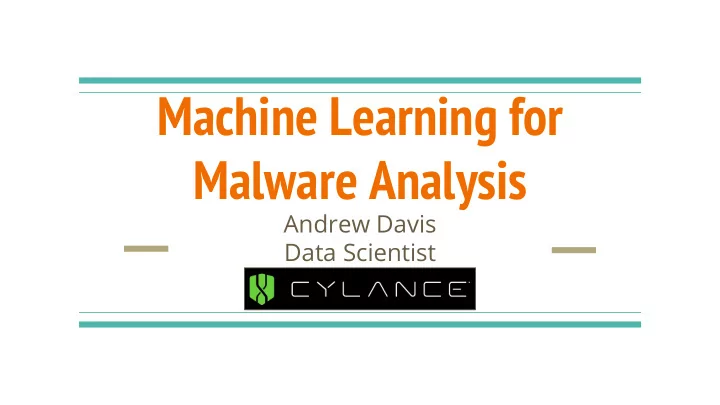

Machine Learning for Malware Analysis Andrew Davis Data Scientist
Introduction - What is Malware? - Software intended to cause harm or inflict damage on computer systems - Many different kinds: - Viruses - Adware/Spyware - Backdoors - Trojans - Ransomware - Botnets - Worms - Rootkits - ...
Malware Detection - Hashing - Simplest method: - Compute a fingerprint of the sample (MD5, SHA1, SHA256, …) 7578034f6f7cb994c69afdf09fc487d9 - Check for existance of hash in a database of known malicious hashes Query DB - If the hash exists, the file is malicious - Fast and simple - Requires work to keep up the database Malicious Benign
Malware Detection - Signatures Look for specific strings, byte sequences, … in the file. If attributes match, the file is likely the piece of malware in question
Signature Example
Problems with Signatures - Can be thought of as an overfit classifier - No generalization capability to novel threats - Requires reverse engineers to write new signatures - Signature may be trivially bypassed by the malware author
Malware Detection - Behavioral Methods - Instead of scanning for signatures, examine what the program does when executed - Very slow - AV must run the program and extract information about what the sample does - Malicious samples can “run out the clock” on behavior checks
Scaling Malware Detection - Previously mentioned approaches have difficulty generalizing to new malware - New kinds of malware require humans in the loop to reverse-engineer and create new signatures and heuristics for adequate detection - Can we automate this process with machine learning?
Focus: Windows DLL/EXEs (Portable Executable) Number of samples submitted to VirusTotal, Jan 29 2017
Portable Executable (PE) Format
Feature Engineering - Static Analysis - What kinds of features can we extract for PE files? - Objective: extract features from the EXE without executing anything - PE-Specific features - Information about the structure of the PE file - Strings - Print off all human-readable strings from the binary - Entropy features - Extract information about the predictability of byte sequences - Compressed/encrypted data is high entropy - Disassembly features - Get an idea of what kind of code the sample will execute
PE-Specific Features https://virustotal.com/en/file/e328b2406d8784e54e77ccc7dbe8e3731891a703e6c21cf7e2f924fa8a42ea5c/analysis/
PE-Specific Features https://virustotal.com/en/file/e328b2406d8784e54e77ccc7dbe8e3731891a703e6c21cf7e2f924fa8a42ea5c/analysis/
PE-Specific Features https://virustotal.com/en/file/e328b2406d8784e54e77ccc7dbe8e3731891a703e6c21cf7e2f924fa8a42ea5c/analysis/
PE-Specific Features https://virustotal.com/en/file/e328b2406d8784e54e77ccc7dbe8e3731891a703e6c21cf7e2f924fa8a42ea5c/analysis/
Feature Engineering - String Features - Extract contiguous runs of ASCII-printable strings from the binary - Can see strings used for dialog boxes, user queries, menu items, ... - Samples trying to obfuscate themselves won’t have many strings
Entropy Features - Interpret the stream of bytes as a time-series signal - Compute a sliding-window entropy of the sample - Information can determine if there are compressed, obfuscated, or encrypted parts of the sample “Wavelet decomposition of software entropy reveals symptoms of malicious code”. Wojnowicz, et. al. https://arxiv.org/abs/1607.04950
Disassembly Features - Contains information about what will actually execute - Disassembly is difficult: - Hard to get all of the compiled instructions from a sample - x86 instruction set is variable-length - Ambiguity about what is executed depending on where one starts interpreting the stream of x86 instructions
Difficulties for Static Analysis - Polymorphic code - Code that can modify itself as it executes - Packing - Samples that compress themselves prior to execution, and decompress themselves while executing - Can hide malicious behavior in a compressed blob of bytes - Can obscure benign code as well - Requires expensive implementation of many unpackers (UPX, ASPack, Mew, Mpress, …) - Disassembly - Malware authors can intentionally make the disassembly difficult to obtain
Modelling - Malicious versus Benign - Boils down to a binary classification task - N: hundreds of millions of samples - P: millions of highly sparse features Malware (s=0.9999) ?? ?? Benign
Modelling - Training on ~600 million samples - Strong preference for minibatch methods and fast, compact models - Logistic regression works very well - Neural networks coupled with dimensionality reduction techniques are the workhorse - Tend to combine lasso, dimensionality reduction, and neural networks
Convolutional Methods on Disassembly push %rbp 55 push %rbx 53 mov %rdi,%rbp 48 89 fd mov $0x718700,%edx ba 00 87 71 00 sub $0x8,%rsp 48 83 ec 08 mov (%rdx),%ecx 8b 0a add $0x4,%rdx 48 83 c2 04 lea -0x1010101(%rcx),%eax 8d 81 ff fe fe fe not %ecx f7 d1 and %ecx,%eax 21 c8 and $0x80808080,%eax 25 80 80 80 80 je 41aa4e <__sprintf_chk@plt+0x18b3e> 74 e9 push %rbp push %rbx mov %rdi,%rbp mov $0x718700,%edx sub $0x8,%rsp mov (%rdx),%ecx add $0x4,%rdx lea -0x1010101(%rcx),%eax not %ecx and %ecx,%eax and $0x80808080,%eax je 41aa4e <__sprintf_chk@plt+0x18b3e> https://www.blackhat.com/docs/us-15/materials/us-15-Davis-Deep-Learning-On-Disassembly.pdf
Convolutional Methods on Disassembly Chunk 1 (1kb) Chunk 2 (1kb) Chunk n (1kb) Global Max Pooling Input Conv+BN+MP Conv+BN+MP
Spatial Structure in Instruction Visualizations
Global Max Pooling → Interpretability
MS Malware Kaggle Dataset 9 malware family classes: ● Ramnit Lollipop Kelihos_ver3 Vundo Simda Tracur Kelihos_ver1 Obfuscator.ACY Gatak 1541 2478 2942 475 42 751 398 1228 1013 ~10k training, ~10k testing ● Provides Ida disassembly and raw bytes, minus the PE header ● Methodology: Separate training data into 90% training, 10% validation ● Use 10k testing samples to generate “pseudo-labels” (semi-supervision) ●
Model Definition
Model Definition
Model: Results Overall Acc 98.30% Ramnit 98.96% Lollipop 99.34% Kelihos_v3 99.57% Vundo 97.47% Simda 90.00% Tracur 99.22% Kelihos_v1 95.89% Obfusc 93.27% Gatak 98.75% #184 on Kaggle leaderboard
Thank You! Questions?
Recommend
More recommend